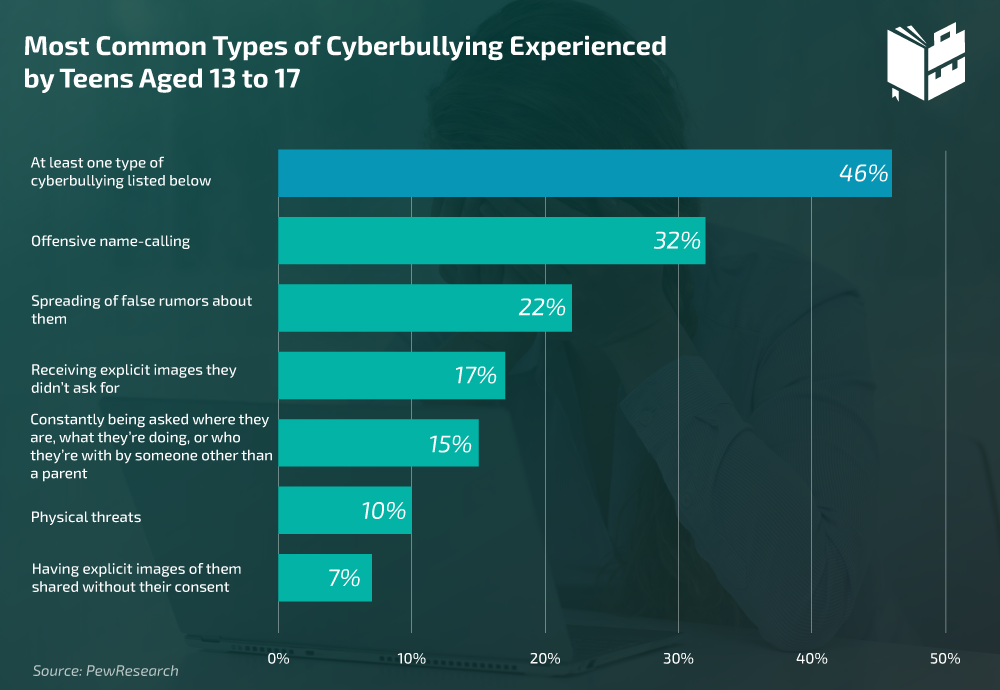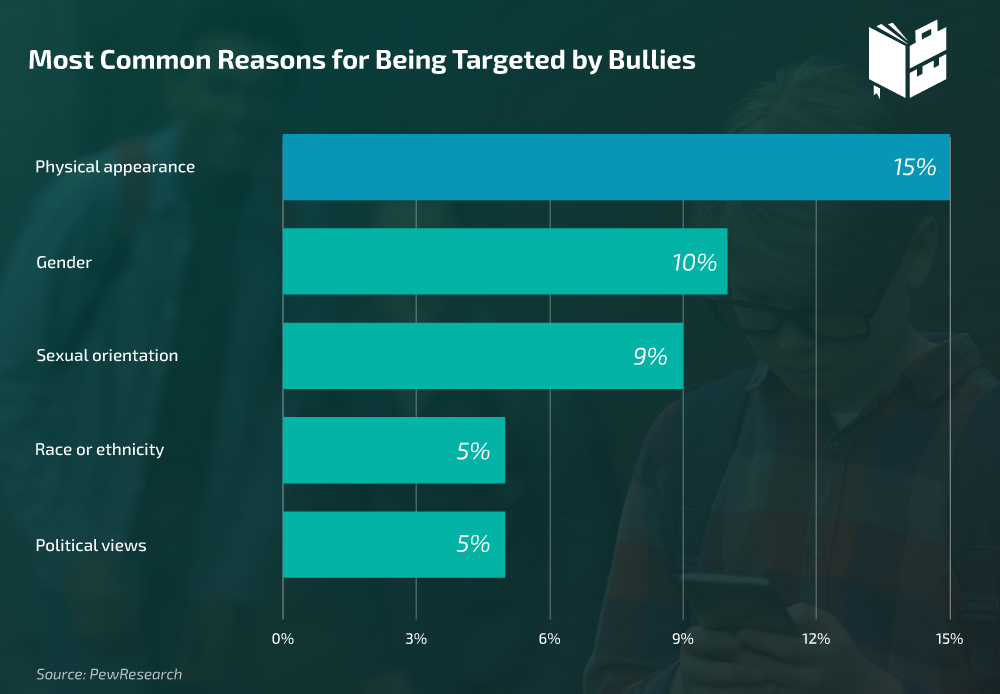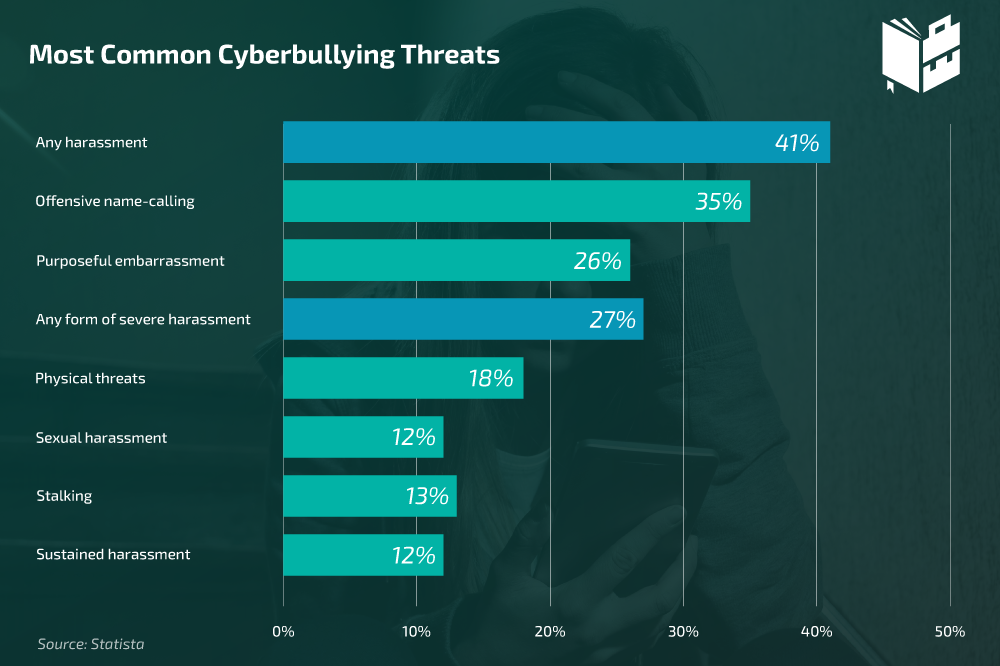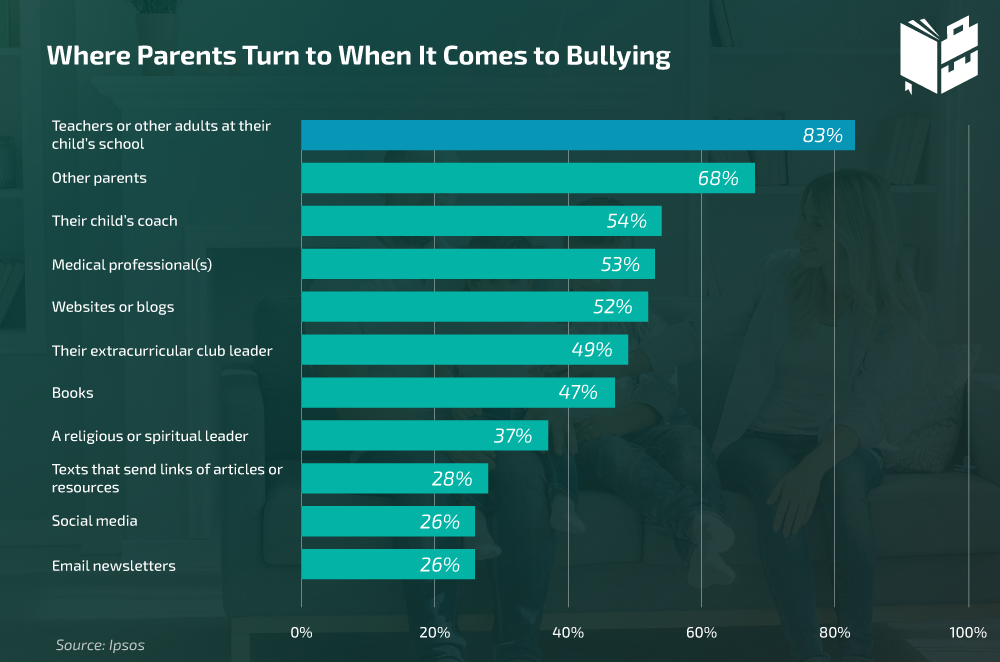Bullying statistics reveal this global issue can take many forms, from physical assault and threatening to insulting and cyberbullying.
Bullying is a common occurrence at school, online, in the workplace, and even at home. Most often, people become subjects of bullying because of their race, sexual orientation, appearance, or disability.
We’re sharing the latest data on bullying in an attempt to shed light on this rising problem and raise awareness.
10 Bullying Statistics and Facts [Editor’s Choice]
- 46% of teens report being cyberbullied at least once.
- 60% of school shooters reported being bullied in person or online.
- Nearly 25% of LGBQ+ students were bullied at school.
- 22% of students get bullied during each school year
- 43%-48% of students reported that they would not intervene in bullying.
- At 79%, verbal harassment is the most common type of bullying at school.
- 84% of bullying in the UK happens through devices such as mobile phones or laptops.
- At 53.8%, Hispanics are bullied the most of all races at work.
- 30% of US workers are bullying victims.
- Rude name-calling is the most common form of child cyberbullying (32%).
General Bullying Stats
46% of teens report being cyberbullied at least once.
At 32%, the most common type of cyberbullying was offensive name-calling.

15% of all teens think they were cyberbullied because of their appearance.
If we only take the number of bullied teenagers into account, 31% of them think the main reason for being bullied was their physical appearance. Gender-wise, girls tend to be picked on more than boys regarding their physical appearance since 17% of female teens reported being bullied on account of their looks, while 11% of boys reported the same.

60% of school shooters reported being bullied in person or online.
According to the latest school shootings caused by bullying statistics, most of the school shooters had social media accounts (88%), while 72% of them reported having at least a single adverse childhood experience.
43% of transgender students have been bullied at school.
LGBTQ youth is more likely to be bullied than straight people. About 43% of young transgender people have been harassed on school grounds. According to transgender bullying statistics, 29% have attempted suicide. Similarly, 21% of gay and lesbian students and 22% of bisexual youth have tried to kill themselves because of experiencing harassment at school.
30% of the LGBQ+ population is electronically bullied.
As the USA bullying statistics show, LGBQ+, females, and students with same-sex partners are more likely to be bullied than other students. Namely, nearly 25% of LGBQ+ students were bullied at school.
27% of bullied students say being bullied negatively affects how they feel about themselves.
Statistics indicate that as much as 19% of bullied students say it has affected their friendships, school work, and relationships with their families. Additionally, bullying facts and statistics report that 14% of students say that bullying has taken a toll on their physical health.
Approximately 20% of teens say bullying has a major impact on their mental health and confidence.
Furthermore, 30% of parents don’t think they have the resources to stop this from happening, while it can’t be neglected that 64% of students drop out of college because of mental health problems.
Bullied students are twice as likely to attempt suicide.
Bullying and suicide statistics show that the suicide attempt rate is 1.9 times higher for victims bullied online and 1.7 times higher for school bullying victims.
Suicide rates for cyberbullying offenders are 1.5 times higher, whereas offenders involved in school bullying are 2.1 times more likely to attempt suicide than those not involved in any type of bullying.
11% of male students are victims of physical bullying, compared to 4% of female students.
According to physical bullying statistics, the percentage of kids between the ninth and twelfth grades being involved in physical altercations is 22%, which is nine percentage points lower than in 2009. The numbers are even lower when talking about physical fights on school property; 8% in 2019 compared to 11% in 2009.
38% of teens say that they have been bullied.
Unfortunately, stats on bullying in the US report that 40% of surveyed teens struggle to report this to their parents or teachers.
Which country has the toughest bullying laws?
The UK, Japan, and Canada seem to have the toughest anti-bullying laws since perpetrators face punishment ranging from school suspension to prison time. However, Sweden is one of the few nations that specifically prohibits bullying.
At 91% each, Sweden and Italy have the highest rate of cyberbullying awareness.
Statistics on bullying indicate that many countries have high rates of cyberbullying awareness. The global average is 75%, with Sweden and Italy topping the list. Chile and South Africa follow with 89% and 88%, respectively, while cyberbullying awareness is lowest in Saudi Arabia, at 37%.
2% of the Dutch population reported being bullied in 2020.
That percentage translates to 240 thousand people, out of which 60% claim to have emotional or psychological issues caused by bullying.
Does Japan have a high bullying rate?
The number of bullying cases in Japan has been growing since 2014, with the exception of 2020. It reached its peak in 2021 when it got to 500.6k cases. However, it’s fair to mention that the number increased dramatically in 2012, after which anti-bullying legislation was introduced to discover bullying at its early stages.
School Bullying Statistics
Sixth-graders experience the most bullying (31%).
The infamous second and third places are taken by seventh and tenth graders, with 25% and 21%, respectively. According to the latest data, the least bullying (15%) happens to those who are in the 12th grade.
School intervention programs, including uniforms, are reported to reduce bullying by 30%-50%.
That said, school uniform and bullying statistics from another study indicate that school uniforms don’t improve child behavior.
How many kids get bullied a year?
Approximately, every fifth student aged 12–18 gets bullied during the school year. According to school bully statistics, around 22% of students get bullied during each school year, which is a significant drop when compared to the last official data from 2009, when the share of bullied students was 28%.
What percent of students are willing to intervene for a friend?
According to the latest stats on bullying in schools, 43%-48% of students reported that they would not intervene in bullying. That’s quite unfortunate since, in 57% of cases, bullying stops when a peer intervenes.
Verbal Bullying Statistics
At 79%, verbal harassment is the most common type of bullying at school.
Social harassment (50%) is the second most commonly reported type of bullying at school, followed by physical bullying (29%) and cyberbullying (25%).
84% of bullied kids in the UK get bullied through communications technology.
Of the above figure, referring to children aged 8 to 17, the majority (or 56%) are bullied via messaging apps, and 43% via social media. On the other hand, in-person bullying happened in 61% of the cases.
Cyber Bullying Statistics
54% of girls aged 15 to 17 have experienced at least some form of cyberbullying.
This is the most prone age group to cyberbullying since 44% of boys the same age and 41% of girls and boys aged 13-14 can say the same.
As of January 2021, 41% of US internet users have experienced some form of cyberbullying.
Online bullying statistics further reveal that 27% have faced severe forms of harassment, such as physical threats, sustained harassment, stalking, and sexual harassment.
Another 26% have experienced purposeful embarrassment, and 35% have been called names. The vast majority (77%) have said the harassment occurred on Facebook.

Which country has the highest rate of cyberbullying?
Research based on parents’ testimony shows that India has the highest rate of cyberbullying (37%). Brazil follows with 29%, and 27% of parents in the US have said their children had been victims of cyberbullying.
Cyberbullying in South Africa is at 25%, in Canada at 20%, and in Turkey at 19%. Russian parents haven’t reported any cases of children cyberbullying, whereas, in Japan, the rate of online harassment reports is at a low of 4%.
Rude name-calling is the most common form of child cyberbullying (32%).
Besides offensive name-calling, spreading false rumors (22%), and receiving explicit images (17%) are common kinds of bullying.
Statistics about bullying indicate that 15% of children are constantly asked who they are, what they are doing, and who they are with. Another 10% of children receive physical threats, and 7% have had explicit images of them shared without consent.
46% of teens aged 13-17 were bullied online at least once in their lifetime.
In addition, 42.2% of teens claim that such bullying incidents happened more than once. The most common types of cyberbullying were online rumors (33.2%), hurtful comments (28.7%), and phone threats (22.5%).
Younger people are more prone to cyberbullying, teen bullying facts confirm. Data shows that 15% of students have cyberbullied someone before with posting mean comments being the main form of cyberbullying they used.
Racism Bullying Statistics
At 53.8%, Hispanics are bullied the most of all races.
They also admit to being bullies 6% more than other racial groups.
Stats regarding racism in the workplace reveal that approximately 47% of Whites, 45% of Blacks, and 32% of Asians are bullied.
21% of Black teens report being bullied due to their race or ethnicity.
11% of Hispanics can say the same, while only 4% of White teens claim someone bullied them because of their racial or ethnic background.
Workplace Bullying Statistics
In the US, 30% of workers experience bullying.
In addition, 43% of the victims are remote workers. The data also shows that 66% of adult Americans are aware of bullying in the workplace.
Bullying levels increased by 12.9% post-pandemic.
This is one of the biggest changes that happened in workplaces stateside since the number of bullying occurrences jumped from 20.1% to 33% in just a couple of years.
67% of workplace bullies are men.
The number of women and men bullied in the workplace is almost equal (49% vs. 51%).
However, data shows 67% of bullies in the workplace are men, and 61% are bosses. In 60% of bullying cases, the bully is the same gender as the victim.
50% of US remote workers reported experiencing or witnessing mistreatment during online meetings.
Another 9% have felt mistreated in group or private emails. The bullying rates between peers have increased during COVID-19, according to 25% of remote workers.
Bullying Statistics by State
48 US states have electronic harassment laws, which include cyberbullying.
In addition, 44 states have included criminal sanctions in their cyberbullying laws. Furthermore, the statistics on cyberbullying show that 45 states have included school sanctions for cyberbullying, 49 have school policies, and 17 include off-campus policies.
27 US states have a sexting law.
Nine explicitly include the word ‘sexting’. Moreover, a total of 47 states have regulations for revenge porn. Seven states include the potential of felony punishment for sexting and 18 list misdemeanor as a possible penalty.
Anti Bullying Stats
70% of teens consider blocking the bully’s account to be the most effective method for stopping cyberbullying.
According to social media bullying statistics, another 34% talk to a friend about the issue, and 28% go offline. On the other hand, a whopping 29% of US teens do not take any action to stop the bullying.
83% of parents turn to teachers if their child is involved in bullying accidents.
With 68%, the second option for them is talking to other parents, while bullying in school statistics say that 54% of them turn to their child’s coach if their kid is involved in a bullying incident. Medical professionals, websites, and blogs take the third and fourth places on the list with 53% and 52%, respectively.

39% of teens say participating in sports events can reduce the level of animosity.
Namely, these children claimed that being involved in sports teams can help them learn kindness, compassion, and inclusivity.
Bullying Statistics – The Rundown
Bullying can take many forms, and the impact can be catastrophic. While it’s easy to turn a blind eye to the effects of bullying, the reality is that this problem requires serious consideration and immediate action. Hopefully, the stats we shared will raise awareness and shed light on the gravity of this issue.